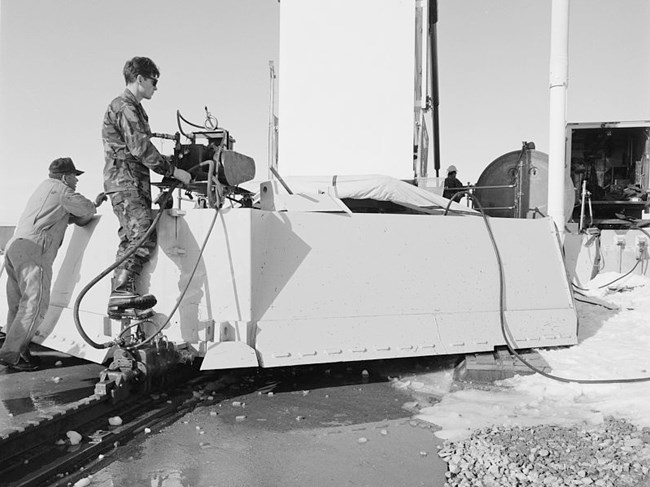
The U.S. Intercontinental Ballistic Missile Force: A Post-Cold War Timeline
The Pentagon is currently planning to replace its current arsenal of intercontinental ballistic missiles (ICBMs) with a brand-new missile force, known as the Sentinel (previously called the Ground Based Strategic Deterrent, or GBSD); it was previously estimated to cost approximately $100 billion in acquisition fees and $264 billion throughout its lifecycle until 2075 (in Then-Year dollars); however, the price tag has since risen substantially, calling the program’s future into question.
Below, you will find a comprehensive timeline of all relevant actions taken relating to the ICBM force since the end of the Cold War, including force posture alterations, international treaties, congressional efforts, government studies, and milestones in the Sentinel acquisition process.
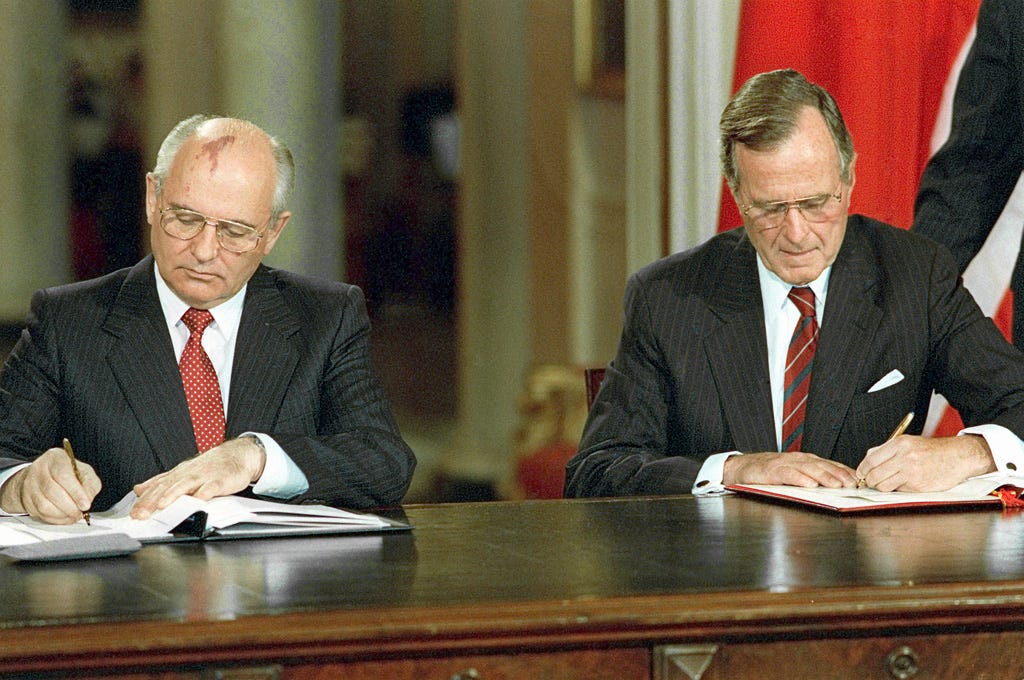
The United States and Soviet Union sign the START Treaty.
START prohibited each country from deploying more than 6,000 nuclear warheads deployed on up to 1,600 strategic delivery vehicles. At the time, the United States’ ICBM force comprised 450 single-warhead Minuteman IIs, 500 three-warhead Minuteman IIIs, and 50 ten-warhead Peacekeeper MX missiles––for a total of 2,450 warheads attributed to 1,000 ICBMs.
27 September 1991
President Bush announces the de-alerting and eventual retirement of all 450 Minuteman II ICBMs.
With the Cold War coming to a close, President Bush took the first steps toward reducing the United States’ land-based nuclear force under the direction of the newly-signed START Treaty.

The first Minuteman II ICBM is removed from Ellsworth Air Force Base’s Golf-02 silo near Red Owl, South Dakota.
The last Minuteman II ICBM at Ellsworth Air Force Base was withdrawn from its silo in April 1994, and the 44th Missile Wing became formally inactive in July 1994.
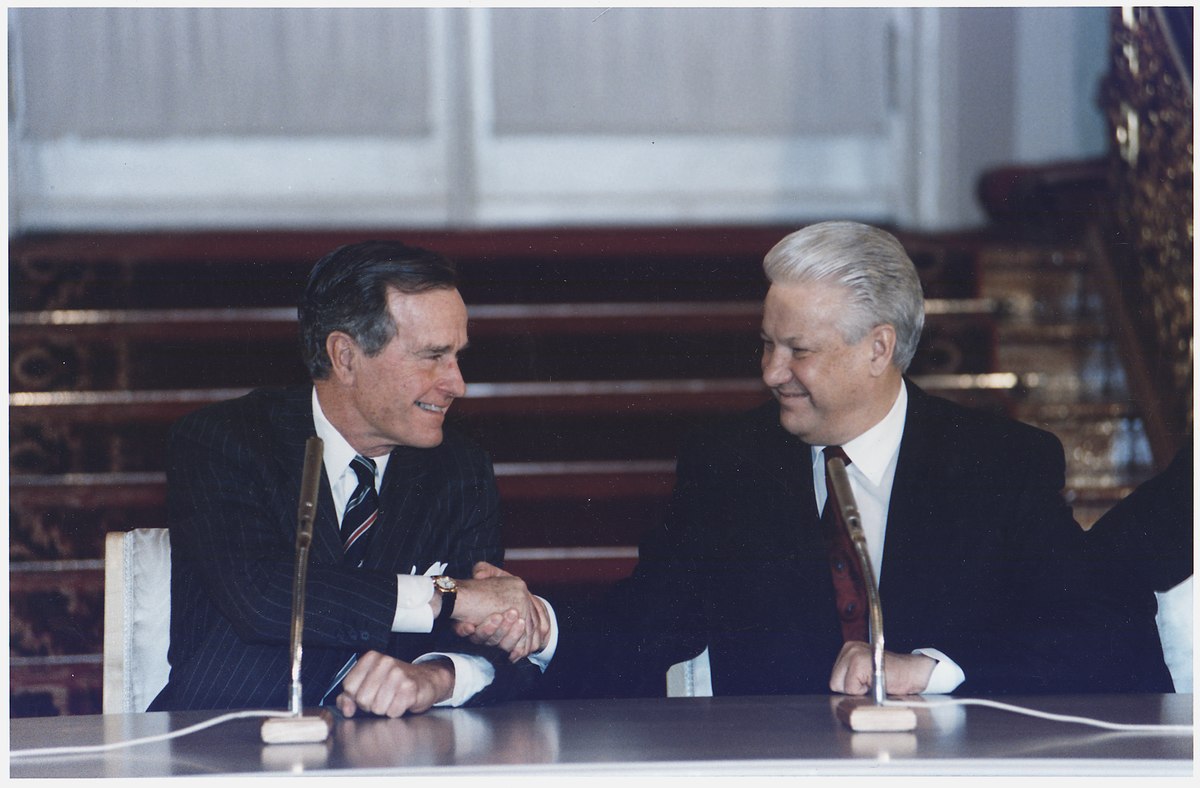
The United States and Russia sign the START II Treaty.
In order to comply with START II’s ban on ICBMs with multiple independently targetable reentry vehicles (MIRVs), the Pentagon planned to retire its 50 Peacekeeper MX ICBMs and de-MIRV its Minuteman III fleet, for an expected future ICBM force of 500 warheads attributed to 500 Minuteman III ICBMs; however, START II never entered into force. After the Strategic Offensive Reductions Treaty (SORT) was signed in 2002, President George Bush eventually did retire the Peacekeepers and download many of the MIRV’ed warheads from the Minuteman III force.
June 1993
GAO publishes an evaluation of the proposed Minuteman III Guidance Replacement Program.
At the time, the Air Force hoped to begin replacing the Minuteman III’s guidance systems with upgraded versions. The GAO’s evaluation, titled” Minuteman III Guidance Replacement Program Had Not Been Adequately Justified,” noted that the Air Force’s own assessments “are not identifying any Minuteman III missile guidance set system-level performance concerns. To the contrary, for the last several years the Minuteman III missile guidance set flight reliability has improved.”
The study further assessed that “missile guidance set failure rates have remained at an acceptable level, with no adverse failure rate trends,” and quoted a previous Air Force study which suggested that “there is no conclusive evidence of degradation within the Minuteman III missile guidance set that cannot be corrected on a case-by-case basis.”
Ultimately, Congress chose to fully fund the $1.6 billion program, which was completed in December 2008.
10 June 1993
GAO publishes its evaluation of the US nuclear modernization program.
The GAO’s evaluation included several notable passages:
p. 5: “We found that the Soviet threat to the weapon systems of the land and sea legs had also been overstated. For the sea leg, this was reflected in unsubstantiated allegations about likely future breakthroughs in Soviet submarine detection technologies, along with underestimation of the performance and capabilities of our own nuclear-powered ballistic missile submarines. The projected threat to the sea leg was, however, used frequently as a justification for costly modernizations in the other legs to ‘hedge’ against SSBN vulnerability. Our specific finding, based on operational test results, was that submerged SSBNs are even less detectable than is generally understood, and that there appear to be no current or long-term technologies that would change this. Moreover, even if such technologies did exist, test and operational data show that the survivability of the SSBN fleet would not be in question.”
pp. 6-7, 14: “Compared to ICBMs, no operationally meaningful difference in time to target was found,” further noting that “SSBNs are in essentially constant communication with national command authorities and, depending on the scenario, SLBMs from submarine platforms would be almost as prompt as ICBMs in hitting enemy targets.”
pp. 7-8: “In comparing performance and cost across the legs and weapon systems of the triad, we were concerned to find little or no prior recent effort by DOD to do what we were doing––that is, evaluate comprehensively the relative effectiveness of similar weapon systems. Yet such agency evaluation is critical if limited budget dollars are to be concentrated on programs that are both needed and effective. With regard to proposed upgrades, we found many instances of dubious support for claims of their high performance; insufficient and often unrealistic testing; understated cost; incomplete or unrepresentative reporting; lack of systematic comparison against the systems they were to replace; and unconvincing rationales for their development in the first place. Where mature programs were concerned, on the other hand, we often found that their performance was understated and that inappropriate claims of obsolescence had been made. […] Perhaps the most important point here is that comparative evaluation across the three legs of the triad–and between individual weapon systems and their proposed upgrades–has been signally lacking. This is unfortunate because it deprives policymakers in both the executive branch and the Congress of information they need for making decisions involving hundreds of billions of dollars.”
p. 14: Nuclear “[command, control, and communications] to SSBNs is about as prompt and as reliable as to ICBMs, under a range of conditions.”
1994
The Clinton administration releases its Nuclear Posture Review.
The first comprehensive review of the United States’ nuclear posture in the post-Cold War era was launched by the Department of Defense under Secretary Les Aspin. The Clinton administration’s Nuclear Posture Review working groups, convened by future Secretary of Defense Ash Carter, considered several proposals that would have eliminated the ICBM force entirely––including Carter’s suggestion to adopt a “monad” of 10 submarines carrying 24 Trident missiles with six warheads each––however, these proposals were quickly shot down. Ultimately, it was decided that ICBMs would remain part of the US nuclear deterrent.
5 December 1994
The START Treaty enters into force.
The START Treaty, signed three years earlier, was the first post-Cold War bilateral arms control treaty to reduce global nuclear arsenals and resulted in an 80 percent reduction of all strategic nuclear weapons in the world at the time of its implementation. The treaty expired in December 2009 and would later be replaced by New START, which was signed by the United States and Russia in 2010.
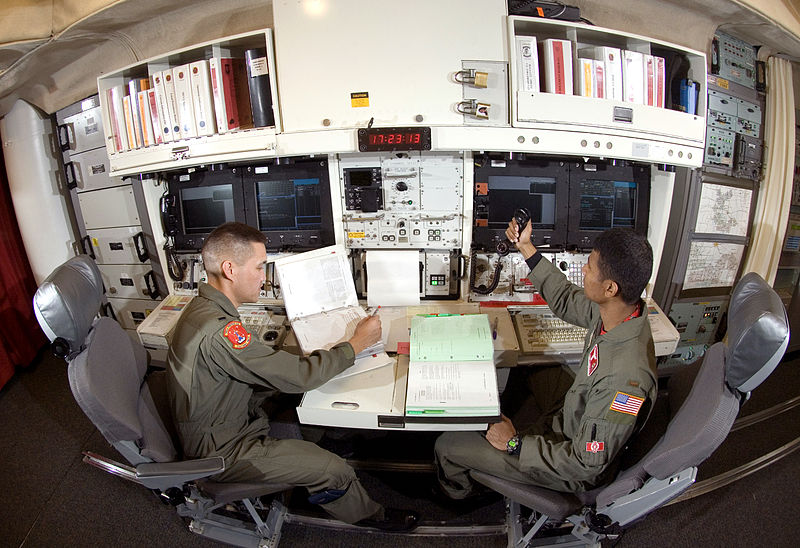
Rapid Execution and Combat Targeting (REACT) upgrade program completed.
The REACT system, originally conceived in the early 1980s, made it possible to retarget the entire Minuteman fleet in under ten hours, and––most critically––allowed missileers to continuously retarget individual missiles as necessary. Although the upgrade was painted at the time as primarily a means of reducing crew fatigue, it also further entrenched the idea of nuclear weapons as “flexible” tools that could be called upon in warfighting scenarios––a strain of thought that continues to dominate nuclear deterrence thinking to this day.
15 December 1997
The Minuteman II elimination process is completed.
The last Minuteman II silo––Hotel-11, near Dederick, Montana––was imploded on 15 December 1997, formally completing the Minuteman II elimination process.
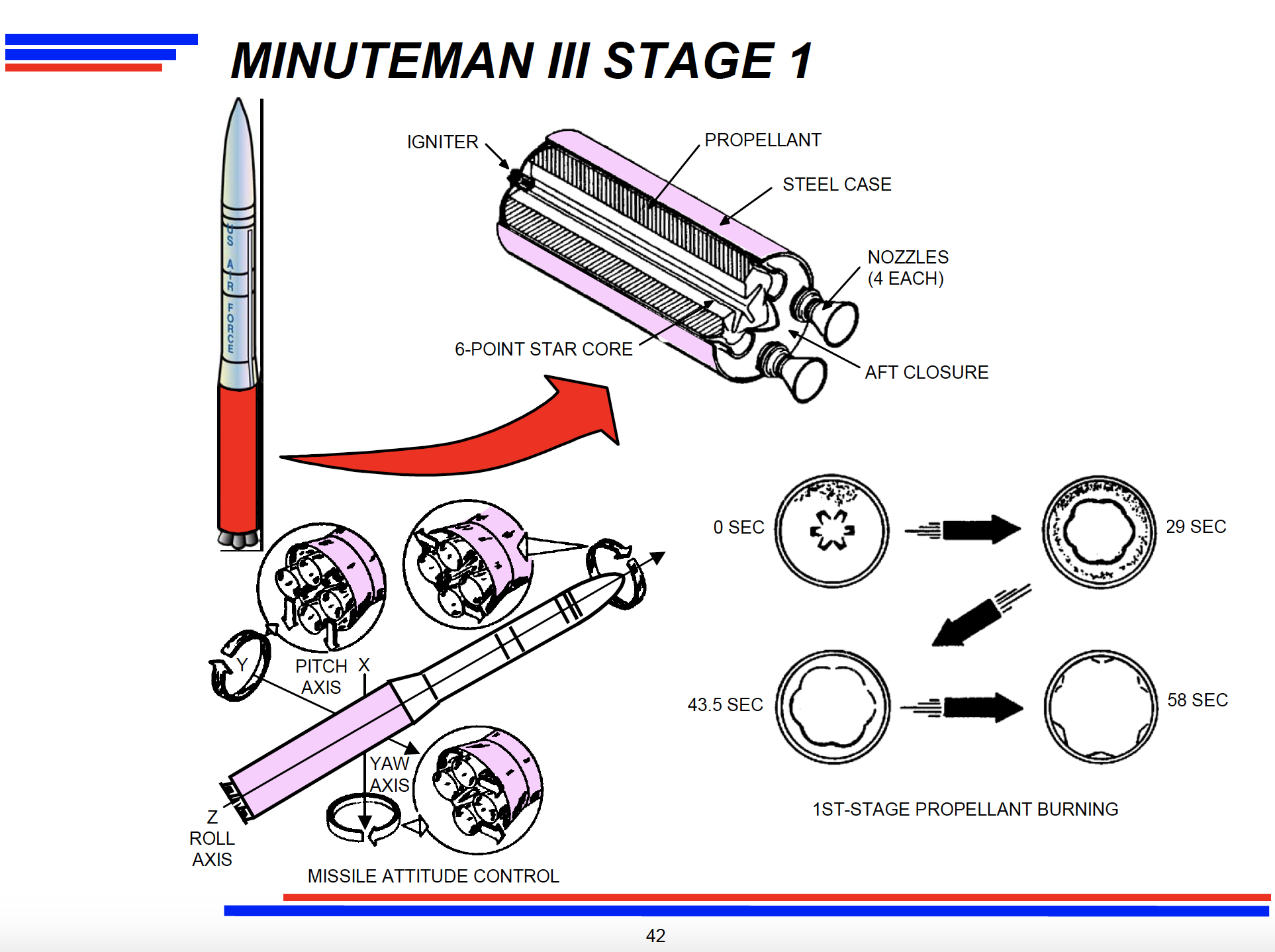
Propulsion Replacement Program (PRP) begins.
The PRP was a life-extension program for the Minuteman III that extended the service lives of approximately 600 solid rocket motors by re-manufacturing all three stages. The first PRP-extended missile was deployed at Malmstrom in April 2001.*
*David K. Stumpf, Minuteman: A Technical History of the Missile That Defined American Nuclear Warfare (Fayetteville: University of Arkansas Press, 2020), p. 395.

Guidance Replacement Program (GRP) begins.
The GRP was a life-extension program for the Minuteman III that replaced both the electronic components of the missile guidance set control and the inertial measurement instruments contained within the gyro-stabilized platform.* The first GRP missile was installed on 3 August 1999 in launch facility I-09 at Malmstrom Air Force Base.**
*David Spires, On Alert: An Operational History of the United States Air Force Intercontinental Ballistic Missile Program, 1945-2011 (Colorado Springs: United States Air Force, 2012), p. 174.
**David K. Stumpf, Minuteman: A Technical History of the Missile That Defined American Nuclear Warfare (Fayetteville: University of Arkansas Press, 2020), p. 397.
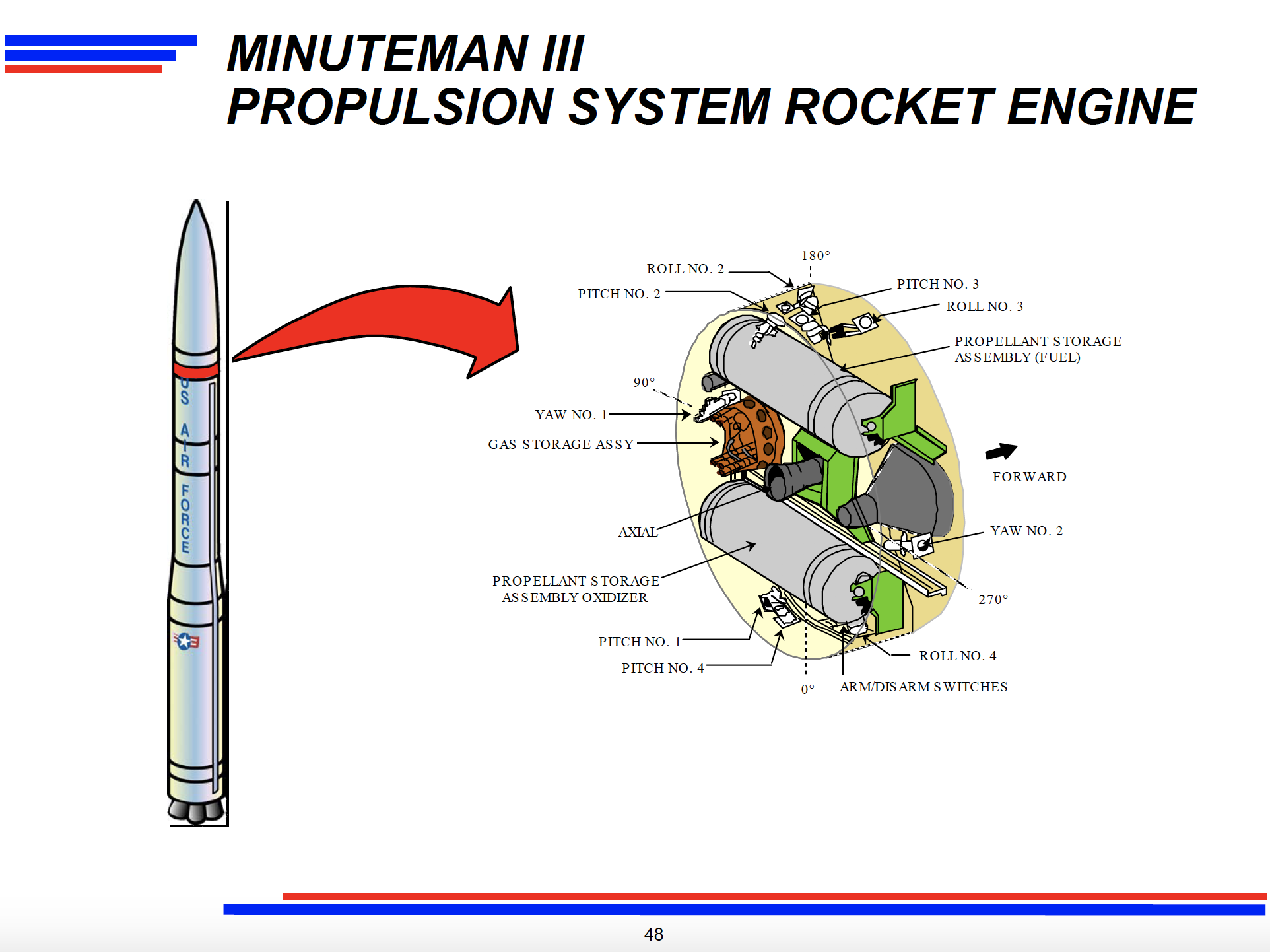
Propulsion System Rocket Engine (PSRE) life-extension program begins.
The PSRE life-extension program was initiated in February 2000 to sustain the Minuteman III missiles’ post-boost propulsion system. The program included the manufacture of 586 PSRE modification kits and cost approximately $107 million to complete.*
*David K. Stumpf, Minuteman: A Technical History of the Missile That Defined American Nuclear Warfare (Fayetteville: University of Arkansas Press, 2020), p. 395.
8 January 2002
Bush administration publishes its Nuclear Posture Review.
This review established a “New Triad” composed of nuclear and non-nuclear offensive strike systems, active and passive defenses, and a responsive defense infrastructure. The report also called for a reduction in the US nuclear arsenal.
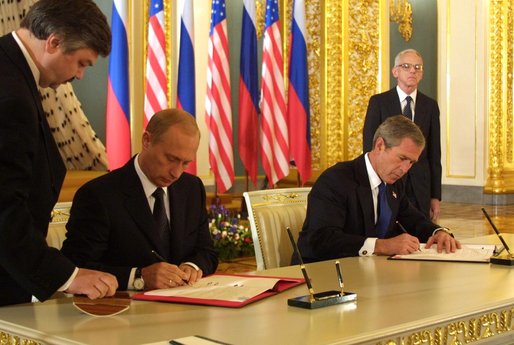
The United States and Russia sign the Strategic Offensive Reductions Treaty (SORT).
Both parties agreed to reduce their nuclear arsenals to between 1,700 and 2,200 operationally deployed warheads each. SORT entered into force on June 1, 2003, and was eventually superseded by the New START Treaty.
October 2002
The Air Force begins to decommission all 50 Peacekeeper ICBMs.
After almost twenty years of service, the LGM-118 Peacekeeper (MX) was phased out as part of the START II agreement (later bypassed by the SORT Treaty) with Russia.
September 2005
The Air Force deactivates the last remaining Peacekeeper ICBM.
As part of the Peacekeeper deactivation, the rockets were converted and repurpose for exploratory space missions (satellite launchers) and the W87 warheads were deployed on the Minuteman III missiles.
6 February 2006
Quadrennial Defense Review announces the reduction of the deployed Minuteman III force from 500 to 450.
The Department of Defense released the QDR in the fifth year of the War in Afghanistan. This review promoted the “New Triad” strategy proposed by the 2002 Nuclear Posture review and emphasized more tailorable approaches to deterrence. The QDR also announced the elimination of 50 additional ICBMs from service, for a remaining force of 450 ICBMs.

Rapid Execution and Combat Targeting (REACT) Service Life-Extension Program (SLEP) completed.
This upgrade modified the Minuteman launch control centers to combine the communications system and weapons system into one console, thereby reducing the number of keys for a launch and the time needed to retarget the ICBM force. The effort was identified as “essential to the future nuclear force,” according to the 2002 Nuclear Posture Review.*
*David Spires, On Alert: An Operational History of the United States Air Force Intercontinental Ballistic Missile Program, 1945-2011 (Colorado Springs: United States Air Force, 2012), p. 178.
October 2006
As part of the SERV program, the Minuteman III three-warhead MIRVs were converted to the single Mk21 reentry vehicles that were previously carried by the Peacekeeper missile. The first SERV Minuteman III was deployed with the 90th Missile Wing at F.E. Warren Air Force Base and placed on alert on 1 January 2007.*
*David K. Stumpf, Minuteman: A Technical History of the Missile That Defined American Nuclear Warfare (Fayetteville: University of Arkansas Press, 2020), p. 396.
17 October 2006
Congress passes the FY 2007 Defense Appropriations Act.
Sec. 139 directs the Secretary of the Air Force to “modernize Minuteman III intercontinental ballistic missiles in the United States inventory as required to maintain a sufficient supply of launch test assets and spares to sustain the deployed force of such missiles through 2030.” This amendment proved to be incredibly 18 consequential because, as Air Force historian David N. Spires describes, “Although Air Force leaders had asserted that incremental upgrades, as prescribed in the analysis of land-based strategic deterrent alternatives, could extend the Minuteman’s life span to 2040, the congressionally mandated target year of 2030 became the new standard.”*

*David Spires, On Alert: An Operational History of the United States Air Force Intercontinental Ballistic Missile Program, 1945-2011 (Colorado Springs: United States Air Force, 2012), pp. 184-185.
12 July 2007
The Air Force begins to deactivate the 50 Minuteman III ICBMs scheduled for retirement.
The 564th Missile Squadron, colloquially known as the “Odd Squad,” used different communications and launch control systems from the rest of the Minuteman III force, and was therefore a clear candidate for decommissioning. The entire decommissioning process was completed in approximately one year, with the final Minuteman III removed from its silo on 28 July 2008.*
*David Spires, On Alert: An Operational History of the United States Air Force Intercontinental Ballistic Missile Program, 1945-2011 (Colorado Springs: United States Air Force, 2012), p. 185-186.
December 2008
Guidance Replacement Program (GRP) completed.
The final GRP missile was installed on 18 February 2008 with the 90th Missile Wing at F.E. Warren Air Force Base, and Boeing delivered the final upgraded missile guidance set to the Air Force in December 2008.*
*David K. Stumpf, Minuteman: A Technical History of the Missile That Defined American Nuclear Warfare (Fayetteville: University of Arkansas Press, 2020), p. 397.
7 August 2009
Creation of the Air Force Global Strike Command (AFGSC).
With major command headquarters at Barksdale Air Force Base, Louisiana, AFGSC is responsible for the three ICBM wings and the entire bomber force. Air Force Global Strike Command is the service component to the United States Strategic Command, and its major command mission was formerly under the direction of Strategic Air Command, which was disestablished in 1992.
November 2009
ICBM Coalition publishes first white paper.
In anticipation of the crucial Senate vote on New START ratification, the white paper implied that the Coalition would deliver the crucial votes to support the treaty if the Obama administration committed to maintaining 450 ICBMs equipped with one warhead each.
March 2010
US Strategic Command sends an ICBM memo to Air Force Global Strike Command calling for an immediate start to a follow-on ICBM.
The memo indicates that the Air Force would have to begin a procurement effort for a follow-on ICBM immediately, if the Air Force planned to deploy it in the 2030 timeframe.*
*Air Force Nuclear Weapons Center, Intelligence and Capabilities Integration Directorate (AFNWC/XR), “Request for Information 12122011” (December 2011), US General Services Administration.
6 April 2010
Obama administration releases its Nuclear Posture Review.
The NPR announced the “deMIRV-ing” of the ICBM force, and called for the Pentagon to begin the Analysis of Alternatives process for a follow-on ICBM in fiscal years 2011 and 2012.
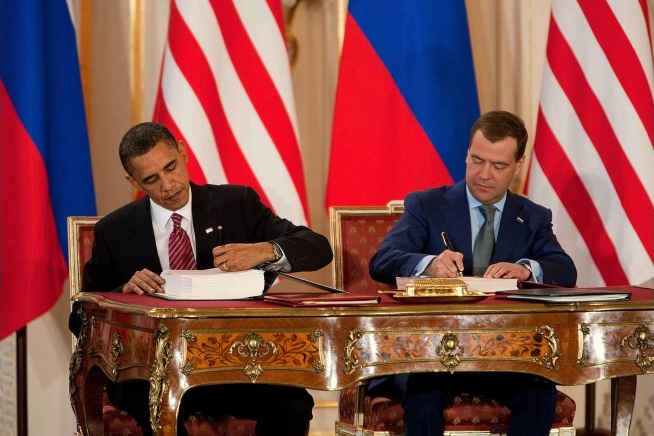
The United States and Russia sign the New START Treaty.
Replacing the START I Treaty, New START placed updated limitations on strategic nuclear arms, including a limit of 1,550 nuclear warheads deployed on no more than 700 strategic delivery vehicles. The treaty was set to have a duration of ten years and was extended in January 2021 for an additional five years.
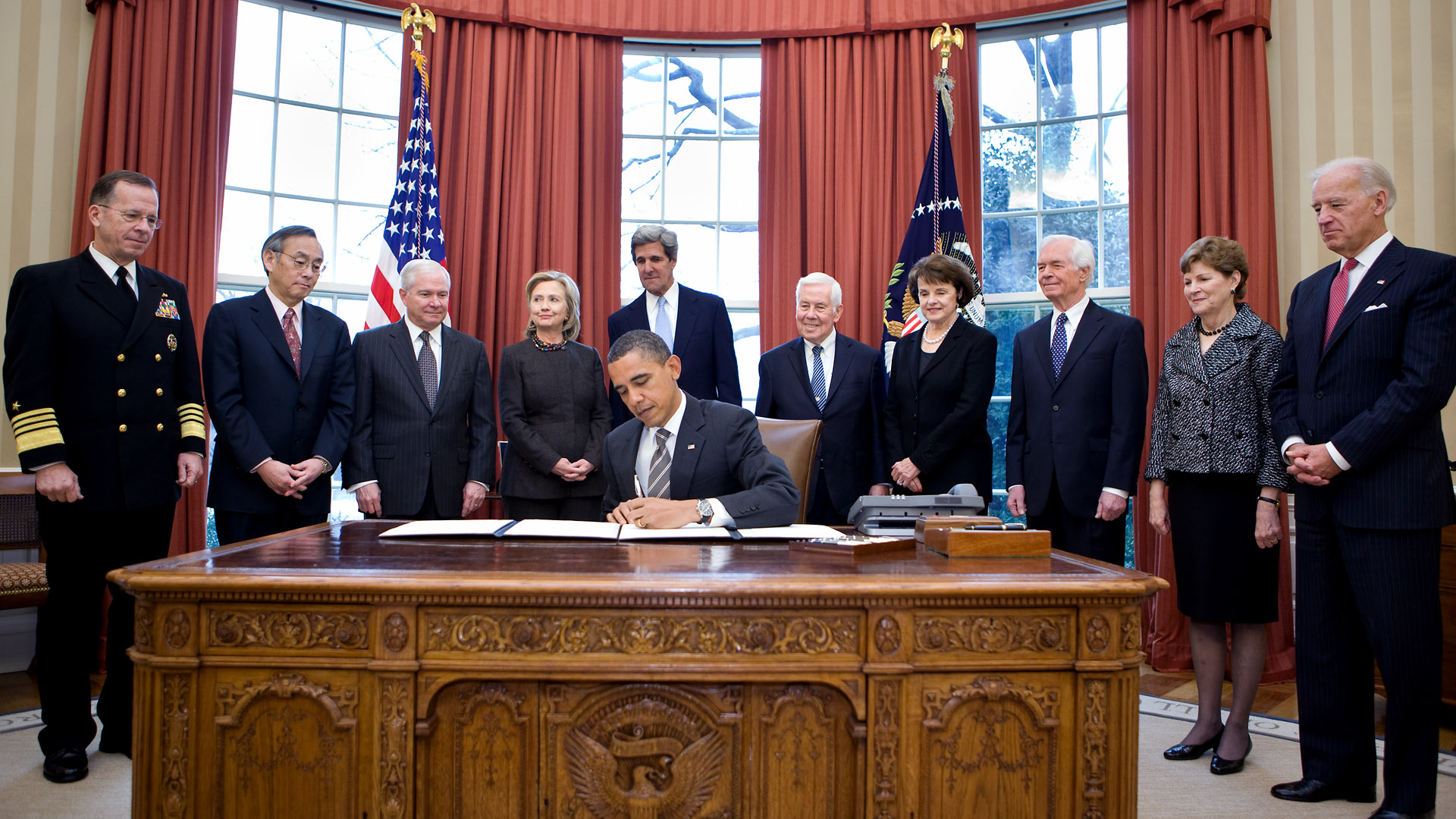
On the same day as the ratification vote, the Obama administration delivered its intended force posture to Congress: the United States would eliminate 30 ICBMs, ultimately retaining a force level of 420 ICBMs with one warhead each. Of the 71 Senators who voted in favor of New START, six of them were members of the Senate ICBM Coalition.
5 February 2011
New START enters into force.
From the date the treaty entered into force, the United States and Russia had seven years to meet the treaty’s central limits on arms reduction. Both parties were in compliance with the central limits in February 2018.
May 2011
Air Force Global Strike Command completes its Capabilities-Based Assessment for the proposed GBSD program.
A Capabilities-Based Assessment (CBA) is one of the earliest elements of the defense acquisition process. It is used to identify the capabilities required to conduct a particular mission, determine whether there are potential capability gaps in the current system and evaluate their associated risks, and provide abstract recommendations for addressing those gaps. This analysis feeds into the subsequent Initial Capabilities Document, which the Air Force completed for the GBSD in May 2012.
December 2011
The Air Force Nuclear Weapons Center issues a Request For Information for the proposed GBSD program.
This RFI – which was based on the conclusions reached in the CBA and still-in-progress Initial Capabilities Document, was intended to solicit “concepts that address modernization or replacement of the ground based leg of the nuclear triad.”* It was one of the first public documents offering significant insight into how the Air Force was imagining the GBSD system at the time. Notably, the Air Force suggested that contractors could “propose innovative deployment and basing strategies, including, but not limited to mobile basing, fixed basing with mobile elements, or hardened silos, in addition to or in place of existing Minuteman III infrastructure.”
*Air Force Nuclear Weapons Center, Intelligence and Capabilities Integration Directorate (AFNWC/XR), “Request for Information RFI-12122011” (December 2011), US General Services Administration.
2012
Safety Enhanced Reentry Vehicle (SERV) conversion for Minuteman III completed.
Although the SERV program was billed as a safety measure due to the new emphasis on configuring the missile fleet with insensitive high explosives, enhanced detonation systems, and other safety features, it also had the practical effect of dramatically improving the Minuteman III’s hard-target kill capability.*
*David Spires, On Alert: An Operational History of the United States Air Force Intercontinental Ballistic Missile Program, 1945-2011 (Colorado Springs: United States Air Force, 2012), pp. 176-178.
May 2012
Joint DOD/DNI Report on Russian strategic forces.
In 2012, the Secretary of Defense and the Director of National Intelligence jointly concluded in a report to Congress that “the only Russian shift in its nuclear forces that could undermine the basic framework of mutual deterrence […] is a scenario that enables Russia to deny the United States the assured ability to respond against a substantial number of highly valued Russian targets following a Russian attempt at a disarming first strike––a scenario that the Department of Defense judges will most likely not occur.”
4 June 2012
An Initial Capabilities Document (ICD) further refines the analysis of the Capabilities-Based Assessment, justifies the need for a material change to the system, and provides a list of capabilities that the proposed new system would need to fulfill. This analysis is required for the acquisition process to proceed. The ICD suggested the following capability requirements for the GBSD: adaptable, effective, flexible, global, reliable, responsive, safe, secure, survivable, sustainable, transportable.
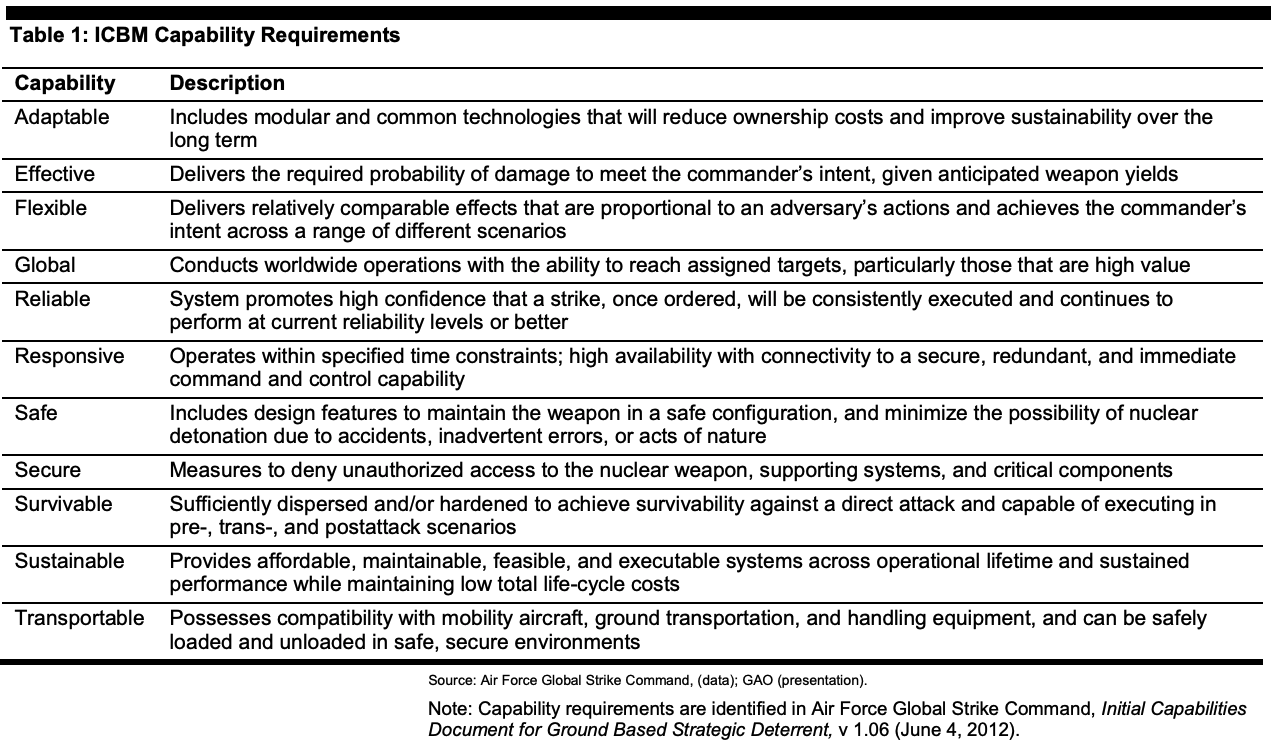
July 2012
Revised US nuclear war plan (OPLAN 8010-12) comes into effect.
As Hans Kristensen suggested at the time, “although very different from the [Cold War-era Single Integrated Operational Plan], OPLAN 8010-12 is still thought to be focused on nuclear warfighting scenarios using a Cold War-like Triad of nuclear forces on high alert to hold at risk and, if necessary, hunt down and destroy nuclear (and to a smaller extent chemical and biological) forces, command and control facilities, military and national leadership, and war supporting infrastructure in a myriad of tailored strike scenarios.”
8 August 2012
The Joint Requirements Oversight Council approves the Air Force’s Initial Capabilities Document and directs it to begin the Analysis of Alternatives process.
The Analysis of Alternatives (AoA) process is a critical component of the defense acquisition process. It compares the effectiveness, suitability, and life-cycle costs of each proposed material solution, and is therefore a key document that influences the system’s ultimate development and acquisition.*
*United States Air Force, “Cost Comparison of Extending the Life of the Minuteman III Intercontinental Ballistic Missile to Replacing it with a Ground-Based Strategic Deterrent: Report to Congress,” Department of Defense (July 2016), p. 4.
2013
President Obama directs the Pentagon to reduce the number of circumstances under which the United States would rely on launch-under-attack.
Jon Wolfsthal, former senior director at the National Security Council for arms control and nonproliferation, subsequently described the implications of this decision as follows: “By openly stating that the United States could, and would, sacrifice its ICBMs in a conflict and still fulfill its missions, the country signaled the reliability and strength of its retaliatory forces.”
2013
Propulsion System Rocket Engine (PSRE) life-extension program completed.
This marked the conclusion of the $107 million contract that the Air Force had awarded to TRW in 2000 for refurbishing the Minuteman III’s liquid-propellant, upper-stage engine that operated during the post-boost phase of flight.*
*David K. Stumpf, Minuteman: A Technical History of the Missile That Defined American Nuclear Warfare (Fayetteville: University of Arkansas Press, 2020), p. 177.
January 2013
The Air Force Nuclear Weapons Center issues a Broad Agency Announcement for the GBSD program.
The Broad Agency Announcement (BAA) is intended to solicit white papers from industry with the purpose of further developing the GBSD design, specifically with an eye towards exploring new basing concepts. In the BAA, the Air Force listed five basing options for further consideration and refinement: “continued use”, “current fixed”, “new fixed”, “new mobile”, and “new tunnel.”*
*Air Force Nuclear Weapons Center, Program Development and Integration Directorate (AFNWC/XZ), “Broad Agency Announcement BAA-AFNWC-XZ-13-001Rev2” (14 January 2013), US General Services Administration.
30 January 2013
Senate ICBM Coalition writes to incoming Secretary of Defense Chuck Hagel, critiquing his participation in Global Zero’s 2012 Nuclear Policy Commission Report, which specifically recommended eliminating US ICBMs.
The eight senators wrote to Hagel requesting a clarification regarding his position on ICBMs in a Global Zero report which Hagel had recently co-authored. The letter inquired as to whether Hagel supported eliminating ICBMs and whether he would support the continuation of the Analysis of Alternatives process for the Ground-Based Strategic Deterrent.
June 2013
The Obama administration completes its review of US nuclear force posture under New START.
Although the administration ultimately concluded that the United States could reduce its deployed strategic forces by up to “one-third”––down to approximately 1,000-1,100 warheads––press reports indicated that the Pentagon contemplated reducing the arsenal to as low as 500 warheads in a plan known as the “deterrence only” approach.
23 July 2013
Allies of the Senate ICBM Coalition in the House of Representatives help quash an amendment to the FY 2014 National Defense Authorization Act that would reduce the number of ICBMs from 450 to 300.
As Illinois Democrat Rep. Mike Quigley’s amendment was defeated by voice vote, he took to the House floor to lambast his colleagues: “I’ve been here for four years, and I now recognize what the Department of Defense is. It is our jobs program. I respect my colleagues defending jobs in their district. But this isn’t about national security, it’s about job maintenance. That’s not what this is supposed to be about. If we’re going to spend money creating jobs, I want to build bridges, schools, and transit systems.”
25 September 2013
The Senate ICBM Coalition writes to Secretary of Defense Chuck Hagel in “strenuous opposition” to the Pentagon’s plan to conduct an environmental assessment on the elimination of ICBM silos.
The environmental assessment would have been prepared as part of the New START implementation process; however, the Coalition called such a move “premature,” suggesting that “Treaty terms do not require the destruction of a single one of the 450 silos housing our Minuteman III force” and that considering such an action “would represent a serious breach of faith.”
18 December 2013
The Senate ICBM Coalition writes another letter to Secretary of Defense Chuck Hagel, as well as to Pentagon Comptroller Robert Hale, in opposition to the Pentagon’s plan to conduct an environmental assessment on the elimination of ICBM silos.
The letter was very similar in tone and substance to the one sent in September 2013, and advocated for the Pentagon to wait until the passing of the defense appropriations bill before taking any actions related to an ICBM silo environmental assessment.
26 December 2013
Congress passes the FY 2014 National Defense Authorization Act.
The bill included a Sense of Congress inserted by allies of the Senate ICBM Coalition which noted that any silos that would soon be emptied due to New START force restructuring should be kept “warm,” so that the silos could be made fully operational on short notice. The amendment also noted that “the distribution of any such warm-status silos should not disproportionately affect the force structure of any one operational intercontinental ballistic missile wing.” This suggests that the Coalition was more preoccupied with economic interests than strategic ones.
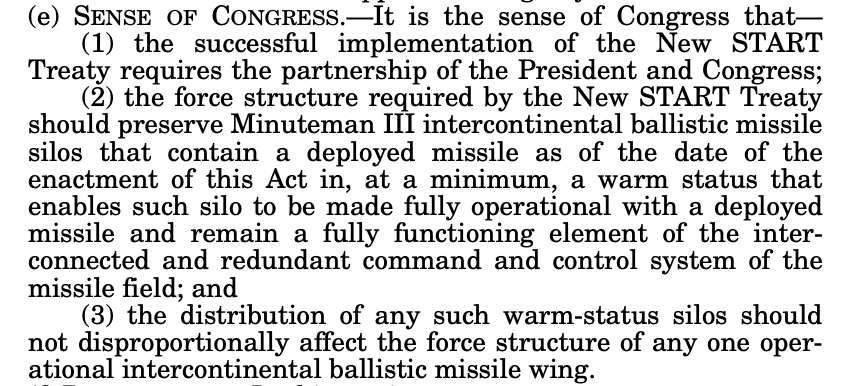
17 January 2014
Congress passes the FY 2014 Defense Appropriations Act.
The bill included language inserted by members of the Senate ICBM Coalition that explicitly blocked the Obama administration from conducting the environmental assessment that would be legally necessary to reduce the number of ICBM silos. In a subsequent statement, Coalition members specifically boasted about how they had overruled the Pentagon on the ICBM issue: “the Defense Department tried to find a way around the Hoeven-Tester language, but pressure from the coalition forced the department to back off.”
16 June 2014
Process of downgrading all Minuteman IIIs from three to one warhead completed.
In order to comply with New START, all remaining Minuteman III ICBMs were downgraded from three warheads to just one per missile.*
*John M. LaForge and Arianne S. Peterson, eds. Nuclear Heartland: Revised Edition (Luck, Wisconsin: The Progressive Foundation, Inc., 2015), p. 9.
July 2014
The Air Force completes its Analysis of Alternatives for the GBSD.
The Air Force’s AoA for the GBSD program recommended a complete replacement of the Minuteman III ICBM with The AoA offered four discrete reasons for its consequential recommendation, noting that a replacement would: address capability gaps and improve performance against current and expected threats; maintain the large solid rocket motor industrial base; share subcomponent commonality with the Navy’s ballistic missiles; and be cheaper than the cost of life-extending the Minuteman IIIs.* In hindsight, and upon further scrutiny, these assumptions appear to have either been flawed, exaggerated, or deprioritized.
*United States Air Force, “Cost Comparison of Extending the Life of the Minuteman III Intercontinental Ballistic Missile to Replacing it with a Ground-Based Strategic Deterrent: Report to Congress,” Department of Defense (July 2016), p. 4.
23 January 2015
The Air Force issues another Request For Information for the GBSD program.
In this RFI, the Air Force offered some additional public information about the proposed GBSD weapon system characteristics, specifically noting that they sought a replacement system that “replaces the entire flight system, retains the silo basing mode while recapitalizing the infrastructure, and implements a new Weapon System Command and Control (WSC2) system.”* Additionally, the RFI stated that the GBSD would utilize the existing Mk12A and Mk21 Reentry Vehicles, in addition to a brand-new missile stack and a potentially reduced number of launch control systems and launch facilities.
*Air Force Materiel Command Lifecycle Management Center, Hill Air Force Base, “Request for Information RFI #1, Ground Based Strategic Deterrent,” Contract Opportunity FA8219-15-R-GBSD-RFI1 (23 January 2015).
February 2015
The Air Force Nuclear Weapons Center completes its initial GBSD cost estimate.
The cost estimate of $62.3 billion (in Then-Year dollars) for 642 missiles over a 30-year period was eventually disclosed to the public on 5 June 2015. The total amount includes $48.5 billion for the missiles themselves, $6.9 billion for command and control systems, and $6.9 billion to renovate and upgrade the launch control centers and launch facilities.
November 2015
The Pentagon’s Office of Cost Assessment and Program Evaluation completes its review of the GBSD Program.
The Office of Cost Assessment and Program Evaluation (CAPE), the Pentagon’s independent budgetary and cost estimation assessment team, estimated that the GBSD would cost between $85 billion and $100 billion (in Then-Year dollars) – a discrepancy more than one-third higher than the Air Force’s original estimate. The Pentagon ultimately selected the lower $85 billion number for the GBSD program.
25 November 2015
Congress passes the FY 2016 National Defense Authorization Act.
The bill specifically prohibited the Pentagon from further reducing the alert level of the ICBM force, with the exception of changes “that are carried out in compliance with the New START treaty.”
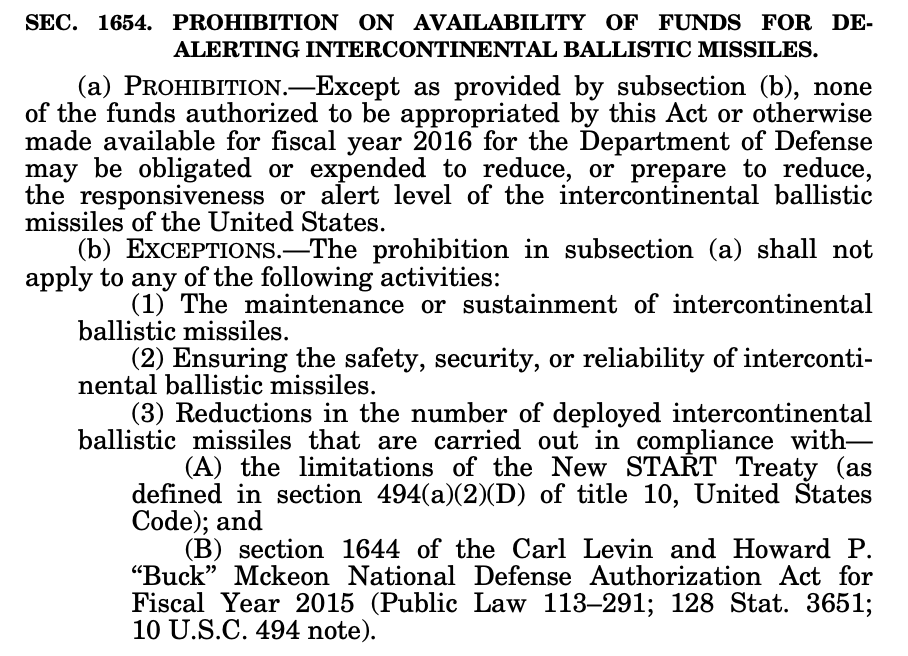
8 July 2016
Senate ICBM Coalition sends a letter to Secretary of Defense Ash Carter about GBSD.
The letter asked Carter to recommit to pursuing the GBSD program “as expeditiously as possible,” in light of concerns “that the Administration now may consider steps to slow down modernization programs or withdraw them from future year defense plans.”
29 July 2016
The Air Force Nuclear Weapons Center releases its Request For Proposals for the GBSD Technology Maturation and Risk Reduction contract.
The Technology Maturation and Risk Reduction phase of a defense acquisition program seeks to reduce technology and list-cycle cost risks, and further refine the requirements of the proposed system. In the RFP, the Air Force noted its intention to award up to two contracts for the TMRR phase of the GBSD program, which was scheduled to last approximately 36 months.
23 August 2016
Under Secretary of Defense for Acquisition, Technology, and Logistics approves the Milestone A decision for the GBSD program.
With the Under Secretary’s decision, the GBSD program formally entered the Technology Maturation and Risk Reduction phase of the acquisition process.* The Acquisition Decision Memorandum that was produced in conjunction with the decision accepted CAPE’s higher estimate of $85 billion for the production of 666 missiles and associated infrastructure costs.
*Now called the Under Secretary of Defense for Acquisition and Sustainment.
12 October 2016
Deadline for Technology Maturation and Risk Reduction proposals.
The Air Force received three submissions: Boeing, Northrop Grumman, and Lockheed Martin.
December 2016
Senate ICBM Coalition publishes a white paper: “The Enduring Value of America’s ICBMs.”
The paper argued that “The administration and Congress should reject any proposal to delay GBSD or extend the life of Minuteman III beyond the currently-planned 2030 timeframe.”
23 December 2016
Congress passes the FY 2017 National Defense Authorization Act.
The bill included a prohibition on reducing the alert level and quantity of deployed ICBMs below 400––a provision that has since been included in every subsequent NDAA to date.
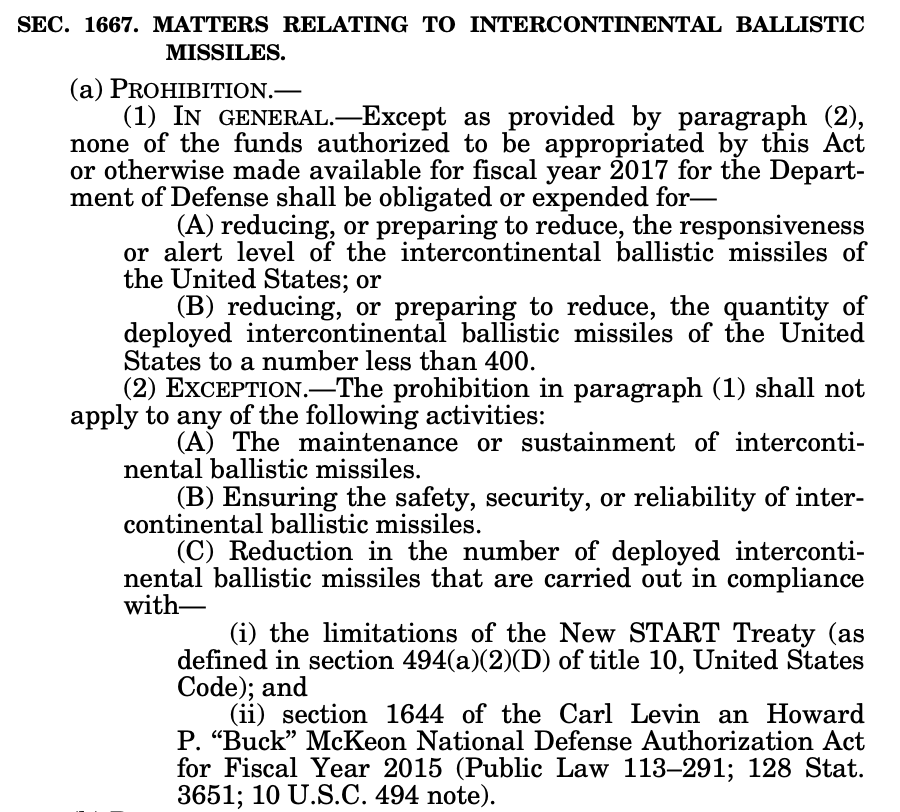
2 June 2017
Process of removing 50 Minuteman IIIs from their silos is completed.
In order to comply with New START’s central limits, 50 Minuteman III ICBMs were removed from their silos. As Congress had previously mandated, these silos were kept “warm.”
21 August 2017
The Air Force awards TMRR contracts to Boeing and Northrop Grumman.
The Air Force awarded two 36-month contracts for the TMRR phase of the GBSD program – one to Boeing for $349.2 million (FA8219-17-C-0001) and one to Northrop Grumman for $328.6 million (FA8219-17-C-0002). Nine days later, Lockheed Martin announced its intention not to protest its exclusion from the competition.
17 September 2017
Northrop Grumman agrees to terms of purchase with Orbital ATK for approximately $7.8 billion.
Over the past several decades, corporate consolidation in the defense industry had dramatically reduced the number of large solid rocket motor producers in the United States. In 1990 there were five, by 2017 there were only two remaining––Orbital ATK and Aerojet Rocketdyne. To that end, Northrop Grumman’s acquisition of Orbital ATK offered it a serious bidding advantage over Boeing––its only competitor for the GBSD program.
October 2017
The Congressional Budget Office estimates the cost of US nuclear modernization to be $1.2 trillion.
The CBO estimated that if the United States delayed GBSD for two decades, then approximately $42 billion (in 2017 dollars) of the costs of replacing the Minuteman IIIs would be pushed beyond 2046. This would allow the total costs of nuclear modernization to be spread out over several decades and alleviate significant budgetary pressures over the coming years. If GBSD was ultimately cancelled, the CBO estimated that this would save $120 billion (in 2017 dollars).
12 December 2017
Congress passes the FY 2018 National Defense Authorization Act.
The bill prevented the Air Force from awarding an engineering and manufacturing development contract for the GBSD that would reduce the number of fixed launch control centers below current levels, unless the Commander of STRATCOM overruled it. This provision, however, was not included in subsequent NDAAs and appears to have been overridden, as the Air Force’s recent Environmental Impact Statement announcement appears to indicate a significant reduction in each missile wing’s launch control centers––from the current 15 to an eventual eight per wing.
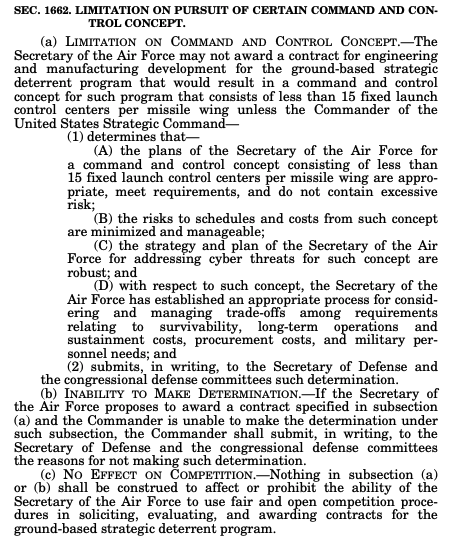
5 February 2018
Both the United States and Russia reach compliance with New START’s central limits.
By this time the United States and Russia were required to meet the Treaty’s central limits of 800 deployed and non-deployed land-based intercontinental ballistic missile (ICBM) and submarine-launched ballistic missile (SLBM) launchers and deployed and non-deployed nuclear-capable heavy bombers; 700 deployed ICBMs, deployed SLBMs, and deployed nuclear-capable heavy bombers; and 1,550 deployed warheads.
March 2018
The Air Force Nuclear Weapons Center drafts a memo seeking “Justification and Approval (J&A) for Other Than Full and Open Competition” for the GBSD program.
Since “full and open competition” for contracts is required by law, an awarding agency must submit a “Justification and Approval” (J&A) request in order to circumvent this procedure. The Air Force Nuclear Weapons Center’s J&A request suggested that limiting the solicitation of the GBSD’s Engineering and Manufacturing Development (EMD) contract to just two bidders––Boeing and Northrop Grumman––would be acceptable because “typically, expected cost savings from a competition come from a competition premium––the cost savings which come from competing a contract rather than soliciting a single supplier. In this case, the [Air Force] expects to obtain a competition premium despite the exclusion of sources, because the selection will be a competition between the two TMRR offerors [sic].”* Given that the EMD contract was ultimately sole-sourced to Northrop Grumman in September 2020, these expected cost savings are unlikely to be realized. The J&A request was ultimately approved by Assistant Secretary of the Air Force William B. Roper, Jr. on 26 February 2019.
*“Justification and Approval (J&A) for Other Than Full and Open Competition,” GBSD program document approved by William B. Roper, Jr., Assistant Secretary of the Air Force (Acquisition, Technology & Logistics), 26 February 2019.
June 2018
Northrop Grumman acquires Orbital ATK for $7.8 billion.
The Federal Trade Commission investigated the merger over concerns that it could “substantially lessen competition and […] create a monopoly in the relevant market for missile systems.” Specifically, the FTC expressed concerns that “If Northrop were to foreclose its missile system prime contractor competitors in any of these ways, the United States Government would be harmed because cost of missile systems may increase, innovation may be lessened, and/or quality would be reduced because the United States Government would be less likely to obtain the best possible combination of missile system prime contractor and SRM supplier.” The FTC ultimately did not block the acquisition; however, it ruled that Northrop Grumman was required to “not Discriminate in any Missile Competition where Northrop is currently competing to be the Prime Contractor.” Specifically, Northrop Grumman would have to make its solid rocket motor products and services fully available to Boeing and would not be permitted to share Boeing’s proprietary data with other parts of the Northrop Grumman corporation to gain leverage over its competitor in other projects.
March 2019
The Air Force’s Deputy Chief of Staff for Strategic Deterrence and Nuclear Integration testifies to Congress that it would be technologically feasible to life-extend the Minuteman III one more time.
When asked about extending the service life of the Minuteman III, Lieutenant General Richard Clark testified, “The propulsion system, the guidance system, even the ability to provide the solid rocket motor fuel, we only have one more opportunity to do that for these weapons.”
18 June 2019
The GBSD Capability Development Document is validated.
The Capability Development Document specifies the operational requirements for the system that is being developed.*
*Department of the Air Force, “Report on Development of Ground-Based Strategic Deterrent Weapon,” Report to Congressional Committees (May 2020), p. 3.
3 July 2019
Northrop Grumman reportedly signs FTC-mandated firewall agreement for the GBSD program.
This agreement was reportedly signed over a year after the FTC’s ruling, and only five months away from the RFP submission deadline for the GBSD EMD contract. According to Boeing CEO Leanne Caret, this delay did not leave Boeing enough time to negotiate a competitive price for solid rocket motors.
11 July 2019
House amendment in FY 2020 NDAA for ICBM study is voted down.
The Senate ICBM Coalition’s allies in the House of Representatives helped quash an amendment to the FY 2020 NDAA that calls for an independent study on a life-extension program for the Minuteman III.
16 July 2019
The Air Force releases its RFP for the Engineering and Manufacturing Development phase of the GBSD program.
The request for proposals process lasted just over a year before the eventual award of the EMD contract to Northrop Grumman in September 2020.
25 July 2019
Boeing announces its withdrawal from the GBSD competition.
In a series of letters addressed to Air Force acquisition executive Will Roper, Boeing Defense and Security CEO Leanne Caret wrote, “We lack confidence in the fairness of any procurement that does not correct this basic imbalance between competitors,” explicitly citing Northrop Grumman’s acquisition of Orbital ATK as evidence that there were “inherently unfair cost, resource and integration advantages” at play.
September 2019
Boeing lobbies both Congress and the Air Force, with the goal of forcing Northrop Grumman into a joint GBSD bid.
Boeing announced that it is actively seeking “government intervention” that would require Northrop Grumman to either add Boeing to its GBSD team as a major subcontractor, or perhaps as a co-equal partner. This effort was ultimately unsuccessful, despite the public support from allies like Senator Doug Jones (D-AL).
3 September 2019
Northrop Grumman formally declines Boeing’s request to form a “best-of-industry GBSD team.”
Boeing officials claimed that a Northrop Grumman-Boeing partnership would produce the GBSD “sooner, and with lower risk than either of us could do alone.” Northrop Grumman declined the offer.
16 September 2019
Northrop Grumman unveils its GBSD team.
Northrop Grumman’s team announcement included the following contractors:
- Aerojet Rocketdyne: solid-fueled rocket motors, post-boost propulsion
- General Dynamics: command and control
- Collins Aerospace: command and control
- Lockheed Martin: command and control, missile payload integration
- Textron System: missile payload integration
- Parsons: engineering, procurement, construction
- BRPH: architectural and engineering
- Clark Construction: construction integration
- L3Harris: training systems
- Honeywell: guidance, missile electronics
The inclusion of Aerojet Rocketdyne is notable, given Northrop Grumman’s prior acquisition of Orbital ATK. However, it remains unclear how much of the overall large solid rocket motor order will be filled by Aerojet and how much will be filled by Orbital, which has since been renamed “Northrop Grumman Innovation Systems.”
25 September 2019
Senate ICBM Coalition sends a letter to Secretary of Defense Mark Esper.
The letter noted the Coalition’s concerns over “recent calls to modify the GBSD acquisition strategy,” and urged Esper to “ensure the GBSD program is not disrupted or delayed.”
October 2019
The Air Force functionally cancels the remainder of Boeing’s TMRR contract for the GBSD.
Given Boeing’s stated intention to not bid for the EMD contract in December 2019, the Air Force refused to allocate any further funding to Boeing’s TMRR contract. This prompted Boeing to immediately issue a Stop Work notice for all GBSD work, stating that “We believe this work would provide substantial value to the Government, irrespective of the fact that Boeing will not participate as a prime offeror under the current EMD [engineering, manufacturing and development] solicitation structure for the next phase of the GBSD program.”
13 December 2019
The RFP deadline for the GBSD’s Engineering and Manufacturing Development contract passes, with the Air Force only receiving a single bid––that of Northrop Grumman.
Northrop Grumman became the default winner of the EMD contract after Boeing declined to bid on the program.
1 July 2020
The House Armed Services Committee rejects an amendment to transfer $1 billion from the GBSD towards Covid-19 relief.
In a bipartisan vote of 44-12, the HASC voted down an effort to transfer GBSD funding to pandemic preparedness, with Committee member Liz Cheney (R-WY) claiming that such an amendment would “help America’s adversaries.”
22 August 2020
CAPE raises its GBSD cost estimate, projecting a new total acquisition cost of $95.8 billion.
This constitutes a near-10 percent increase from the $85 billion figure adopted by the Pentagon in 2016. The cost breakdown is listed as follows: $25.5 billion for research and development, $61.6 billion for missile procurement, and $8.7 billion for military construction, plus an additional $166.6 billion for long-term support costs and $1.4 billion for disposal. CAPE’s projection for the GBSD’s total life-cycle cost is set at $263.9 billion (in Then-Year dollars) through 2075. This new estimate was provided to Congress in September.*
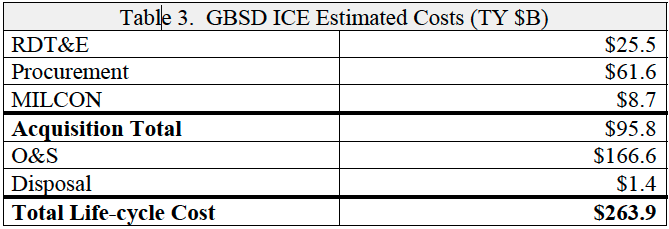
*Under Secretary of Defense for Acquisition and Sustainment, “(U) Ground Based Strategic Deterrent Milestone B Summary: Report to Congress,” Department of Defense (September 2020), p. 5, retrieved through FOIA 21-F-0065 on 24 November 2020.
4 September 2020
Under Secretary of Defense for Acquisition and Sustainment approves the Milestone B decision for the GBSD program.
A Milestone B approval is necessary in order to award an Engineering and Manufacturing Development contract.*
*Previously called the Under Secretary of Defense for Acquisition, Technology, and Logistics.
8 September 2020
The Air Force awards the $13.3 Engineering and Manufacturing Development contract for the GBSD to Northrop Grumman.
The EMD contract is expected to run through February of 2029, and the contract includes weapon system design, qualification, test and evaluation, and nuclear certification.
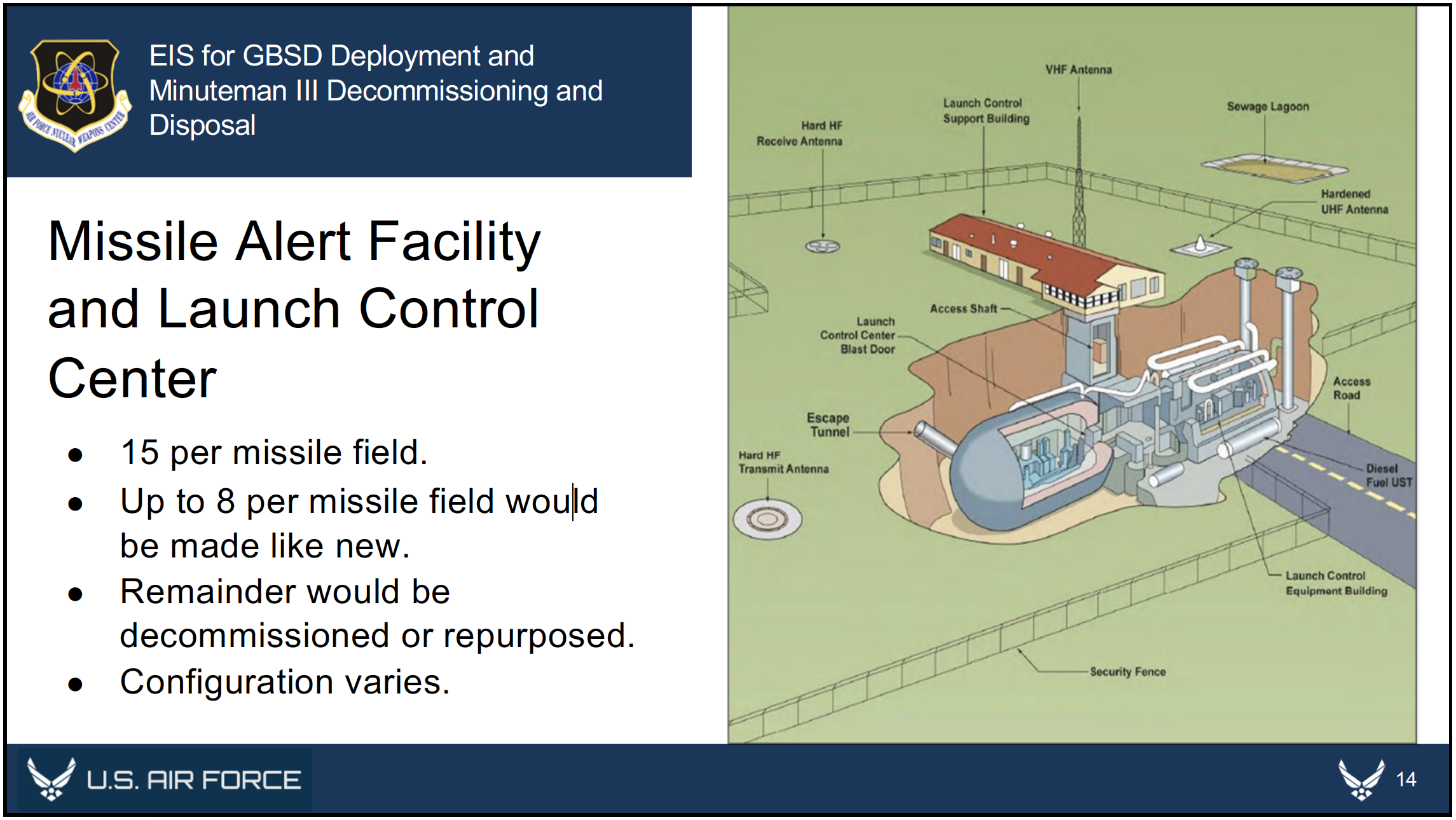
25 September 2020
The Air Force issues a Notice of Intent to prepare an Environmental Impact Statement (EIS) for the GBSD.
The Air Force’s GBSD EIS website reveals that the number of launch control centers at each missile wing will be reduced by nearly half, and that substantial GBSD-related construction is expected to take place at all three ICBM bases, in addition to Hill Air Force Base and the Utah Test and Training Range.
Spring 2022
The Draft Environmental Impact Statement for the GBSD is scheduled to be released, and will be available for public comment.
Click here to read the schedule.
2023
Construction and deployment is scheduled to begin at F.E. Warren Air Force Base, and is expected to be completed by 2031.
Spring 2023
The Final Environmental Impact Statement for the GBSD is scheduled to be released.
2025
Construction and deployment is scheduled to begin at Malmstrom Air Force Base, and is expected to be completed by 2033.
2026
The NNSA is scheduled to produce up to 30 plutonium pits per year by 2026.
These pits will ultimately be used to produce the W87-1 warhead, which will be used for the GBSD. Given that the United States has not had the capability to produce more than 10 plutonium pits per year for over two decades, it is widely expected that this ambitious schedule will be delayed.

2027
Construction and deployment is scheduled to begin at Minot Air Force Base, and is expected to be completed by 2036.
April-June 2029
The Air Force projects the GBSD to reach Initial Operational Capability.
In order to reach IOC, the GBSD program must complete the Minuteman III-to-GBSD transition for 20 Launch Facilities––each loaded with an in-silo missile and deployed with a Mk21/W87-1 warhead––three Launch Control Centers, and one Integrated Command Center at the same missile wing as the three Launch Control Centers (likely to be F.E. Warren).*
*Department of the Air Force, “Report on Development of Ground-Based Strategic Deterrent Weapon,” Report to Congressional Committees (May 2020).
2030
The NNSA is scheduled to produce up to 80 plutonium pits per year by 2030.
According to the Government Accountability Office, “it is not clear that NNSA will be able to produce sufficient numbers of pits—the fissile cores of the primary—to meet the W87-1 warhead’s planned production schedule.”

2036
The Air Force projects the GBSD to reach Full Operational Capability.
In order to reach IOC, the GBSD program must complete the Minuteman III-to-GBSD transition for all 450 Launch Facilities, at least 24 Launch Control Centers (eight per wing), three Integrated Command Centers, and command and control infrastructure for all three missile wings.*
*Department of the Air Force, “Report on Development of Ground-Based Strategic Deterrent Weapon,” Report to Congressional Committees (May 2020).
The FY2026 National Defense Authorization Act (NDAA) paints a picture of a Congress that is working to both protect and accelerate nuclear modernization programs while simultaneously lacking trust in the Pentagon and the Department of Energy to execute them.
While advanced Chinese language proficiency and cultural familiarity remain irreplaceable skills, they are neither necessary nor sufficient for successful open-source analysis on China’s nuclear forces.
Satellite imagery has long served as a tool for observing on-the-ground activity worldwide, and offers especially valuable insights into the operation, development, and physical features related to nuclear technology.
This report outlines a framework relying on “Cooperative Technical Means” for effective arms control verification based on remote sensing, avoiding on-site inspections but maintaining a level of transparency that allows for immediate detection of changes in nuclear posture or a significant build-up above agreed limits.